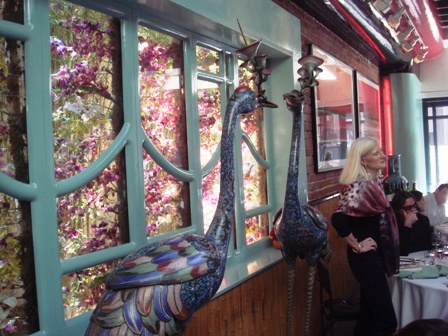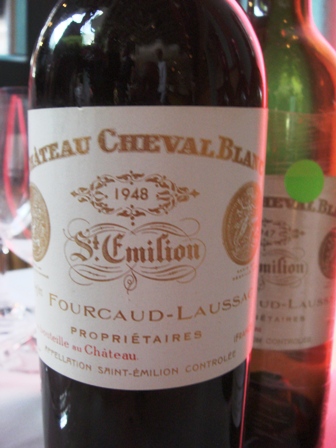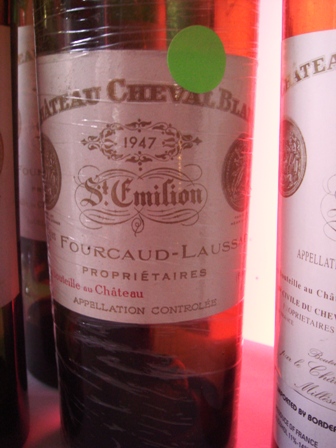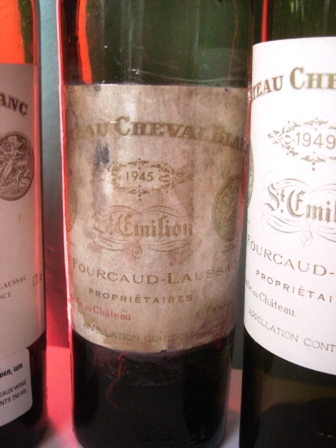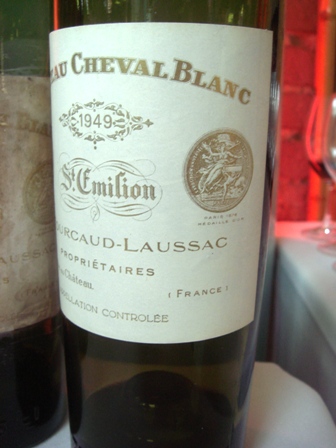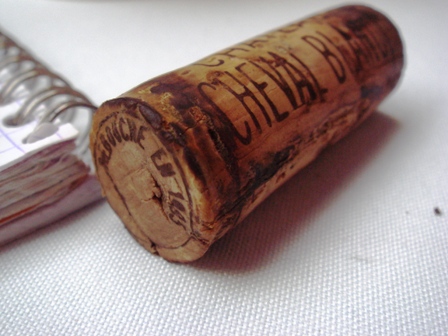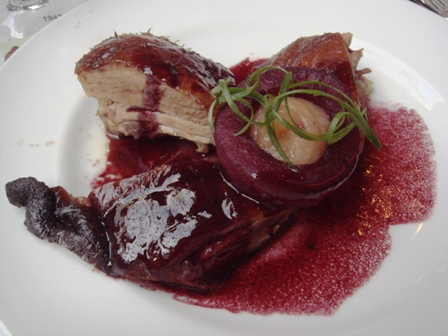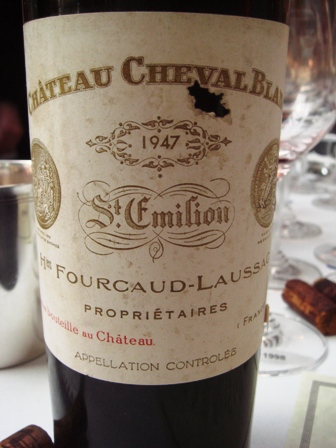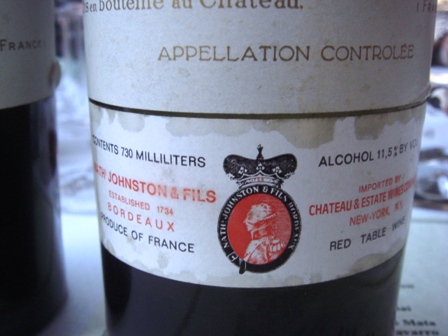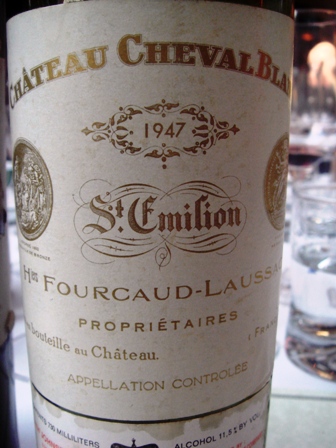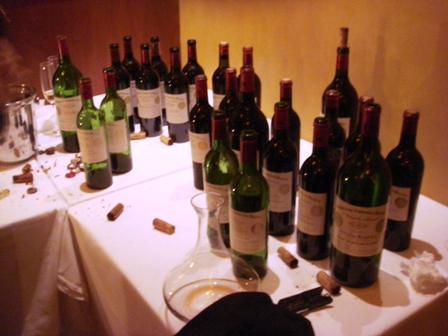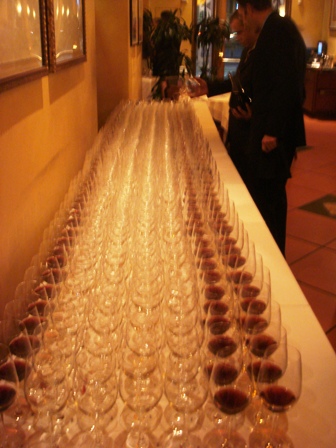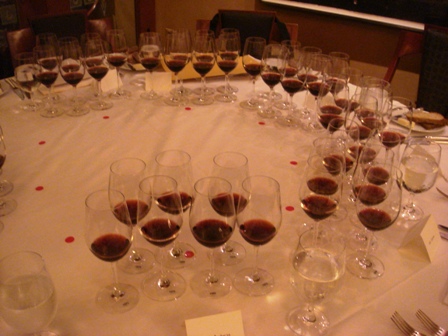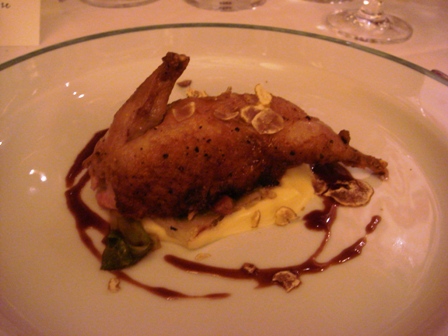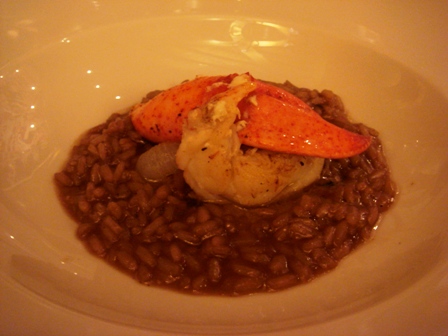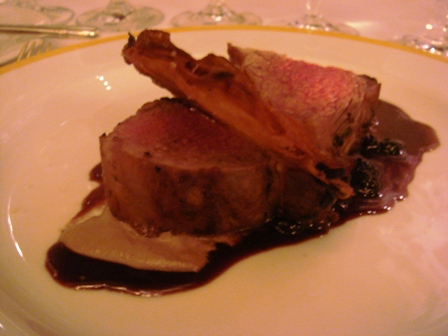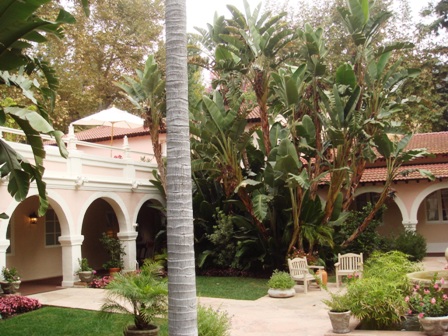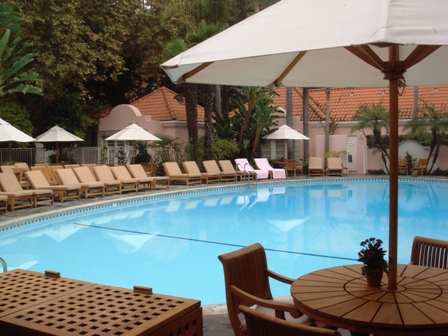Tasting of Cheval Blanc in Los Angeles – report of John Kapon, head of Acker Merrall auction house.
John makes remarkable notes on wine tastings and is one of the references in tasting of old wines. Notes can be found on his web site.
The stars were once again aligned for a spectacular weekend in Los Angeles, orchestrated by none other than Dr. Bipin Desai. While the BCS standings may have been on many people’s minds heading into early November, it was the BCW (Bipin Cheval Weekend) that was on the collective collectors’ minds of those fortunate enough to get a seat at this sold out event. Bipin has become renowned for his wondrous wine weekends that he holds periodically in Los Angeles, as well as Bordeaux, Paris and other parts of the globe occasionally. This weekend brought Bordeaux to Los Angeles, along with Pierre Lurton, managing director of Cheval Blanc and d’Yquem. He was on hand to guide us through 35 vintages of Cheval Blanc, St. Emilion’s most collectible wine, and this weekend would prove that claim to be deservedly so.
Most of the wines came directly from the Chateau, which is a rarity when it comes to older wines. In fact, demand has been so great in Bordeaux at the top Chateaux that one could say it is becoming a rarity for younger wines as well! But to find wines seventy years or so old from the Chateau is very rare and a testament to the library at Cheval Blanc. Even though Bipin had two bottles of every wine for this event, he told me that the demand for this event was one of the most extraordinary that he has ever seen, and he has done hundreds of these wine weekends. He actually had to turn people away, as much as that pained him.
As usual, it was Friday night, and I had just stepped off a plane in time for dinner. I smelled all the wines first for each flight. I was feeling a bit under the weather, though the wines of Cheval Blanc quickly brought good feelings back.
We started with the 1988, whose nose was fabulous, again, since the last time I had had this wine was with Pierre himself at Cheval Blanc. This bottle also had great aromas of sweet red fruits, green and black olives, cherry, nut and a touch of cola. The palate was red and rusty with nice tannins and alcohol. The 1988 is in a great spot right now, and Michael Twelfthtree, famous Australian winemaker, was also loving it, and James Suckling admired, its ‘really fresh quality and licorice’ (93).
The 1985 was a bit milky in the nose, with lots of bell pepper up front. There was earth and beef behind it and very subtle red fruits. It opened up more to reveal brooding and deep t n’a. The palate was really big, chunky and muscular, with black olive and black fruit flavors. It was a big wine by Cheval standards, and although James found it a bit off, I found that in time, it found itself in the glass. It was massive compared to the 1988 (95).
The 1979 was similar to the ’85 with its upfront bell pepper and touches of milk, earth and beef. There was also a pinch of szechuan; ’79 seemed like the ‘85’s little brother, possessing less overall of everything. It got greener in the glass and revealed wintergreen flavors. It lacked length, but was still very good. Pierre admired the ’79, citing that ‘acidity is the backbone of wine’ (90).
Pierre also noted that the 1978 was picked rather late, on October 8th. There were lots of green olives in the nose, and again that touch of bell pepper, but the green olive was the dominant trait herein. It was musky and more aromatic in the gamy direction, and also more forward with its earth components, a bit toasty with lots of campfire qualities. Fleshy, rich and very tasty in the mouth, it possessed light rose and a kiss of green olive and mint (92).
The 1975 evoked Gil, aka Mr. Wine Vegas, to call this, ‘the bell pepper flight.’ The ‘75 had more wintry and waxy fruits to go with its green olive, and it also had some animal, complete with fur. The palate was rusty but also a bit musty with hot tannins and flavors that were a bit dried out. Pierre remarked, ‘In general, there were unbalanced wines in 1975, and a big wall of tannins in most’ (88?).
The 1971, my birth year, was very pungent and olive-y. It was the most open of the flight, wintry and minty in its personality, but also possessing red fruits, almost red citrus fruits. It was round and soft with a nice hint of sweetness to its fruit, yet still rusty.
Subdued yet forward and expressive, Gil and I preferred the 1971 to the 1970 that followed. Gil observed, ‘Cali weed and rose petals in the nose.’ Pierre also preferred the 1971 to the 1970 (92+).
Bipin preferred the 1970, whose plummy, nutty, figgy and gamy qualities set it apart from the rest of the flight. There was just a touch of menthol and cedar in its singular nose. The palate had nice richness and more plum flavors, meatier in style, and its acidity took over in the glass. Francois Audouze, our Parisian representative, hailed the 1970 as best of flight, followed by the 1988, 1971, 1985 and 1978, in that order (90).
The warm-up was over, and it was time to get serious for the 1955. The 1955 had a complex nose of wheat and exotic, jammy, smoky, sexy red fruits. Sweet and kinky, it had the cherry, raspberry and strawberry trifecta. It was almost as if a shot of Yquem was in the glass; it was that sweet. The palate was gamy and figgy, a touch oxidized, but in that natural date and cola way. There was a bit of ‘old painting varnish’ according to Gil. It did have that round autumnal edge to its fruit flavors (93).
The 1953 saw a return to the smoky, campfire aromas previously seen in the ’78. Fresh and also sexy, it occurred to me that this bottle was perhaps reconditioned, and indeed it was, in 1985. Big time cinnamon aromas emerged. There was great elegance and balance to the palate, and flavors of raisins, red fruits and wintergreen abounded. It was gorgeous, but just ‘not the best bottle that I had’ according to someone (94).
I should note that many of the older wines came directly from Cheval and were reconditioned. Although I am generally not a fan of reconditioning, I must say, for the most part, that Cheval did a particularly good job with their reconditioning, and that outside of the general freshness of some of the older wines, it was tough to say that many were definitely reconditioned. Due to the format and timing, I was not able to find out exactly which wines were reconditioned for this session, although I managed to find out more for the second session that followed on Saturday.
The 1952 didn’t taste right to James. There was cinnamon again, ‘solera’ according to Gil. It also had some hoisin. The mouth had that touch of metal, definitely reconditioned and probably the worst job of the evening. It was simply not what it should be, but others found it spectacular, which meant that the second bottle (which I did not try) was better than the first. This wine should be in 95-97 point territory; it can be killer (90?).
The 1937 had old cobwebs in the nose, with lots of dust and rust that gave me a haunted house impression. It was fully mature; beautiful, long and caressing with great old flavors (93).
The 1934 had a ‘whiff off doggie poo’ right off the bat, almost masquerading for Burgundy, according to Gil. James also observed that he forgot how Burgundian Cheval can be. There was great aromatic complexity in the ’34; rust, earth, wintergreen, old book and carob were all present. The palate was round and rich with great t n’a, but the acidity is what really made this wine stand out from every other so far. ‘What acidity!’ was how I put it, to be exact. There were also complex caramel and rust flavors on its lengthy finish. Christian Navarro loved the ’34 the best, and Michael La Tondre also said that the ’34 was his favorite, noting its, ‘Cohiba cigar, candied raspberry and tremendous finish’ (96).
Now began the flight of young bucks, beginning with the 2004. The 2004 was obviously a baby by comparison to the wines that we had just had, and it was full of baby fat fruit accordingly. It was still sappy and sweet with lots of dark, sweet fruits, incredibly concentrated and full of crushed black cherry and black raspberry oil. The palate was rich, balanced and long, possessing big time chocolate flavors and earthy spice. The fruit was rich, full of coffee flavors, with excellent minerals on its concentrated finish (93+).
The harvest in 2003 was the earliest picking since 1893. There was even more coffee and chocolate in the nose, along with a touch of beef stew and hot earth and smoky aromas. The palate was ripe and forward, gamy and sweet, a bit of a floozy. It had ‘light brick with lots of dark chocolate’ flavors per Gil, and lots of liquid vitamins on its finish (92).
The 2001 was very aromatic with its candied red and black fruits and had a splash of cough syrup. Tangy and sweet, it also had this almost blueberry profile, most likely due to a large percentage of merlot. There were lots of coffee and vitamin flavors. It still had classic fruit, nice definition and beautiful balance. The tannin was very vimful, and those vitamin flavors really made me lick my mouth. It was another excellent right bank wine from the 2001 vintage (94).
We entered the evening with a bang, that being the 2000. Big, chunky and clearly on another level, the 2000 had huge breed and divine aromas of chocolate, coffee, espresso, graphite, black cherry, blueberry, motor oil, vitamins, pine forest and cedar. Now that’s a complex nose! The palate was exquisite; long, fine, balanced and elegant. It reminded me what the 2000 Bordeaux tasting did; 2000 is the new 1982 (96+).
Saturday brought us back for lunch at Chinois, where nineteen more wines awaited us eager participants. Friday night had left us wanting more, and Saturday definitely delivered. We started with the 1999, which had a shy and brooding nose. It was a much more masculine style of Cheval. There was lots of earth and minerals, and slowly penetrating t n’a in its very cedary nose. The wine was round and rich in the mouth, again cedary yet also foresty, long and big in its profile. Its taut, rusty fruit was a bit square, and it seemed that this wine has closed up a bit since the last time I’ve had it a few years ago (92).
The 1996 was also cedary, yet olive-y, and its wood qualities were a kiss too much; in fact, it had the most noticeable oak of the weekend, and that’s not a good thing. The palate was better, more olive-y yet still cedary and square, but it had a tasty edge that the ’99 lacked. Medium weight, tender and tangy, the ’96 had red fruit flavors, and I preferred it to the ’99 on this day, but would much rather have the ’99 in my cellar. The oak blew off a bit, and while everyone ultimately liked the 1983 best in this first flight, most also preferred the 1996 next. It was the most open and friendly in the flight, but it also had the least weight. Someone observed, ‘smoked chili, light raspberry and invigorating minerality’ (91).
The 1995 had much more wildflower and lavender in the nose, yet was again cedary with bell pepper and chocolate aromas. In the mouth, the wine was round and rich, with lots of t n’a, flirting with hot. Its fruit flavors were rusty, and there was citrus on its finish. It opened up and had a real rusty ‘pop’ to it’s a finish, so much so that Bipin called it a ‘revelation’ (92+).
The 1989 was the greenest of the bunch, as always, with lots of bell pepper, olive and this puttanesca tomato sauce edge, so much so I wanted to throw some pasta in it. The ’89 was actually in a tasty spot, but it seems very forward and on a fast track to maturity. Lush, round, fleshy and tasty, it had sweet green pepper flavors that won’t get any better. Pierre observed its overall merlot and leathery nose. Although I think it won’t get any better, this bottle of ’89 was in a good spot, and even though it was green, Jef professed that he liked it with ‘I like green.’ Shroomy qualities developed as well (93).
The 1983 Cheval Blanc was punishingly wound, with searing t n’a, minerals and sawdust. I had to swirl what seemed like 1,000 times to get past the minerals, but behind the minerals were sappy, menthol, olive, game, wintergreen and asian spice aromas along with meaty fruit. The palate was round and rich with tremendous acidity that seemingly lasted forever. The ’83 shattered the rest of the flight, and its great core of rich, red fruits, brick, fireplace, asian spice, hay and minerals even left Bipin, ‘very impressed.’ That same someone from before admired, ‘uncountered delicacy, dust, earth and bouillon’ (95+).
The 1983 reminded Jef of how he likes the concept of great ‘shadow years,’ ie the vintages after the great years like 1983 after 1982, 2001 after 2000, etc., and has been very successful with some purchases along those lines.
The next flight began with a 1966, which had wonderful aromatics, although Serena Sutcliffe, whom I had the pleasure of sitting with, was very sensitive to some chlorine in the glass. Once we worked past that, there were tender and sweet aromas of winter, cherries, minerals, earth, candle wax and a touch of sexy sweat. While the aromatics were nice, the palate was very, very dry and lean, with no sweetness whatsoever and a citrus-y, dry and uninspiringly earthy personality (88).
The 1964 formed an instant glee club, with Serena, Ed and Jef loving every minute of it. It was very fragrant, with lots of red fruits but also this cassis and fig quality. It was very stony with lots of t n’a, but this ’64 was all about its great fruit. Round, balanced, long and tender, its flavors of old sweet cherry, tender leather, mineral and book were flat out beautiful (95).
The 1962 had a super sweet, long nose that was very plummy, chocolaty, figgy and a touch yeasty. There were nice dusty flavors, and the ‘62 was along the lines of the ’66 stylistically in the mouth, but it had some shreds of fruit left, a pat of nice cassis left in its round and smooth palate. It got a little limey in the glass, but not negatively (91).
The 1961 had a killer nose that was very racy with lots of vigor and t n’a. It was also very sweet in a musky, nutty, caramel-y way. There was lots of oil in this rich and nutty wine, and as soon as I tasted it, I flashed to 1971 and ‘76 Grange. This menthol/eucalyptus craziness was total Grange. It was rich, hearty and full of strawberry flavors. Bipin concurred that ‘this was always one of the sweeter ‘61’s,’ and likened it to a ‘bon-bon’ (94).
The 1959 had a reticent nose with some sweet caramel creeping out. Francois fell in love with the ‘59 immediately, calling it, ‘completely perfect’ and having a future that will last ‘forever.’ The nose got deeper, chunkier and beefier, while hints of bread and dust and acidity oozed out slowly yet firmly. The palate was rich and creamy, absolutely delicious; it was so creamy and so sexy that it was easy to see how it tickled Francois’ fancy (96).
Bipin spoke about the fact that ‘every bottle was what it should be…candied sweetness and all…all the alcohol levels are 12.5% or less, and people say you need alcohol to age.’ I believe I heard a ‘harumph’ out of him next. He also went on to say that in the sixties, many wineries chaptalized to get the alcohol levels just to 12%, but today, due to the climate change, wines are naturally 13-14% alcohol. This was one of the most fascinating comments made all weekend, and it really made me think about the state of winemaking then versus now. Today, winemakers seem to be pushing the envelope as far as the alcohol levels in their wines, partly perhaps due to climate, but mainly due to intention. After having tasted so many glorious wines over the years from the 1870s up through the 1980s (I think it is safe to say that higher alochol levels are a product of the ’90s until now), how could one argue that wines could age any better with higher alcohol levels? I am no chemist, and I have not done any lengthy comparative studies, but I do know that most winemakers whose wines I prefer always talk about acidity and not alcohol. Even Pierre acknowledged acidity as the backbone of wine earlier, and if you talk to the Burgundians, it is all about the acidity as far as aging potential. Perhaps high alcohol levels are not at all what they are cracked up to be.
The third flight was again full of young bucks, but this trio was high powered enough to put the Three Tenors to shame – make that Three Mo’ Tenors for Manny and Wilette (go see it New York!). The flight began with a 1998. The 1998 had a great nose, wound up a coiled, yet deadly with its venom, packed with sweet, sappy and dark purple fruits. There were lots of minerals, along with black cherry and cola aromas. The palate had great minerality. It was long, elegant and fine, yet substantial. I believe it was Serena who called it, ‘absolutely mind blowing and better than the 2000…crashingly good’ (96+).
The 1990 had a deep, sexy nose full of green olives and wintergreen. It had this open, waify edge to its black fruit and lots of garden aromas as well. The palate was so lush, long and tender with its cascading waterfall of fruit flavors. It was so elegant, possessing garden, forest, and olive flavors. Incredibly complex, Serena also ‘loved it’ (97).
The 1982 had a lean nose by comparison to the first two that was very shy and dominated by wintergreen at first. Touches of roses and cherry lingered behind. The palate was great, however, and it even had a flash of meaty fruit. Elegant yet rich, long yet balanced, tender yet full, this was one of the better bottles that I’ve ever had of this wine, which has been notoriously all over the map, at least in my experiences. This bottle of ’82 had similar qualities to the ‘90 yet more in reserve, almost a nose in winter hibernation. Serena put the ’82 third in this flight of three and found it to be ‘not what you expect.’ I found this flight to be great and a bit of a photo finish (96).
The first wine of the spectacular last flight was the 1949, which was slaty and wound at first, again more of a glass issue than anything else. I couldn’t get much out of the nose accordingly, but the palate was extraordinary. Rich and balanced, there were great slate borders to its decadent cherry core, and great roundness, balance, tannin and definition, and just a twist a tootsie pop to this beautiful, gorgeous wine (95).
The 1948 was even better; the power jumped right out of the nose; that sweet rust, licorice, nut and this ice skating rink/’glace’ complexity and edge. The flavors were so great, so rusty, so spicy and foresty, mineraly, slaty and earthy as well, full of cherry cola. Once again the 1948 stole the show and was ultimately the wine of the weekend, although the bottle of ’47 I would have with Rudy and Gil later that evening would lay claim to the wine of the weekend throne (98).
The 1947 that I had during afternoon’s session was unfortunately a touch oxidized, with this burnt brown sugar quality to the nose, port like in its personality. Thick, long, spicy and rusty, this affected bottle was still drinkable and still excellent. The other bottle of ‘47 served that afternoon had much more rust and life, but I only got a small swallow, and the bottle that I was officially served was (94A).
The 1945 had gorgeous, tender red fruits. Dusty and sandy in its personality, it still had great sweetness in the nose and great flavors to match. Its flavors were more on the citric side of the flavor rainbow, but there was still sweet strawberry as well as flavors of actual straw giving this wine tremendous complexity. The wine possessed superb acidity and was stunningly gorgeous, very fresh and danced in my mouth (96).
The 1921 had cobwebs and tender red fruits in its nose, along with wax and leather. One could see it was very old, but this Nicolas bottle proved about as fresh as a 1921 could be. Very gamy with lots of delicious caramel flavors, the wine was round and old, tender with lots of leather and older flavors, graceful yet forceful (95).
I looked at some of the corks on this day and noted that the ‘62, ‘59, ‘49, and ‘48 were reconditioned in 1985, although it is possible one bottle was and one bottle wasn’t since two bottles were served. The 1966 was reconditioned in 1991, and the ‘64 and ‘61 were original corks, at least the corks that I saw.
Serena gave a great speech at the end of the event, summing up some of her keen observations, so I will share some of those observations with you.
She called 1995 and 1996 ‘an interesting comparison’ and admired the 1995 and its ‘richness of merlot.’ The 1953 had ‘charm,’ while the 1955 was ‘meaty.’ The 1952 was ‘mind-blowing, the best bottle that I have ever had.’ The 1970 was ‘particularly good,’ and it was as if she was looking through a door for Cheval, because that was the last year they bottled in Libourne. The 1959 was ‘utterly dominant, so mouth-filling it wasn’t true.’ The 1988 was ‘always classic,’ and how in general Cheval was exotic with its ‘cinnamon, cloves, Russian leather and sweetness.’ She finally reminisced about how she never thought that people would still be looking for the 1947 over thirty years ago.
Bipin then got up to reminisce about how he once bought six bottles of 1947 Cheval about thirty years ago for the price of 420 pounds, and how he later found out that he had won a tie bid with none other than one of his now best friends, Ed Lazarus. Bipin continued that at the time, he was just starting out in wine while Ed was already a legend, so this minor victory was something major in his evolution as a wine collector. Bipin wrote a great article about 1947 Cheval Blanc and Petrus for World of Fine Wine Magazine recently with many more great anecdotes about those wines. It is worth seeking out.
Bipin took me aside at the end and remarked how it was good to see so many people still appreciating old wine, and that he couldn’t understand this seemingly overall public disdain for old wines. ‘What public?’ I asked. ‘Not my friends!’ ‘Yes, yes, I know you know, and that your friends know, but it is the people that do not know that need to know.’ Well, now you all know lol. There wouldn’t be cellars if wine wasn’t meant to age. I, for one, will do my part to remind everyone that the greatest wines are meant to be drunk old.
Pierre also had an interesting comment in the end, something that I will end this report with: ‘Sometimes in nature, defects can become exceptional things.’
